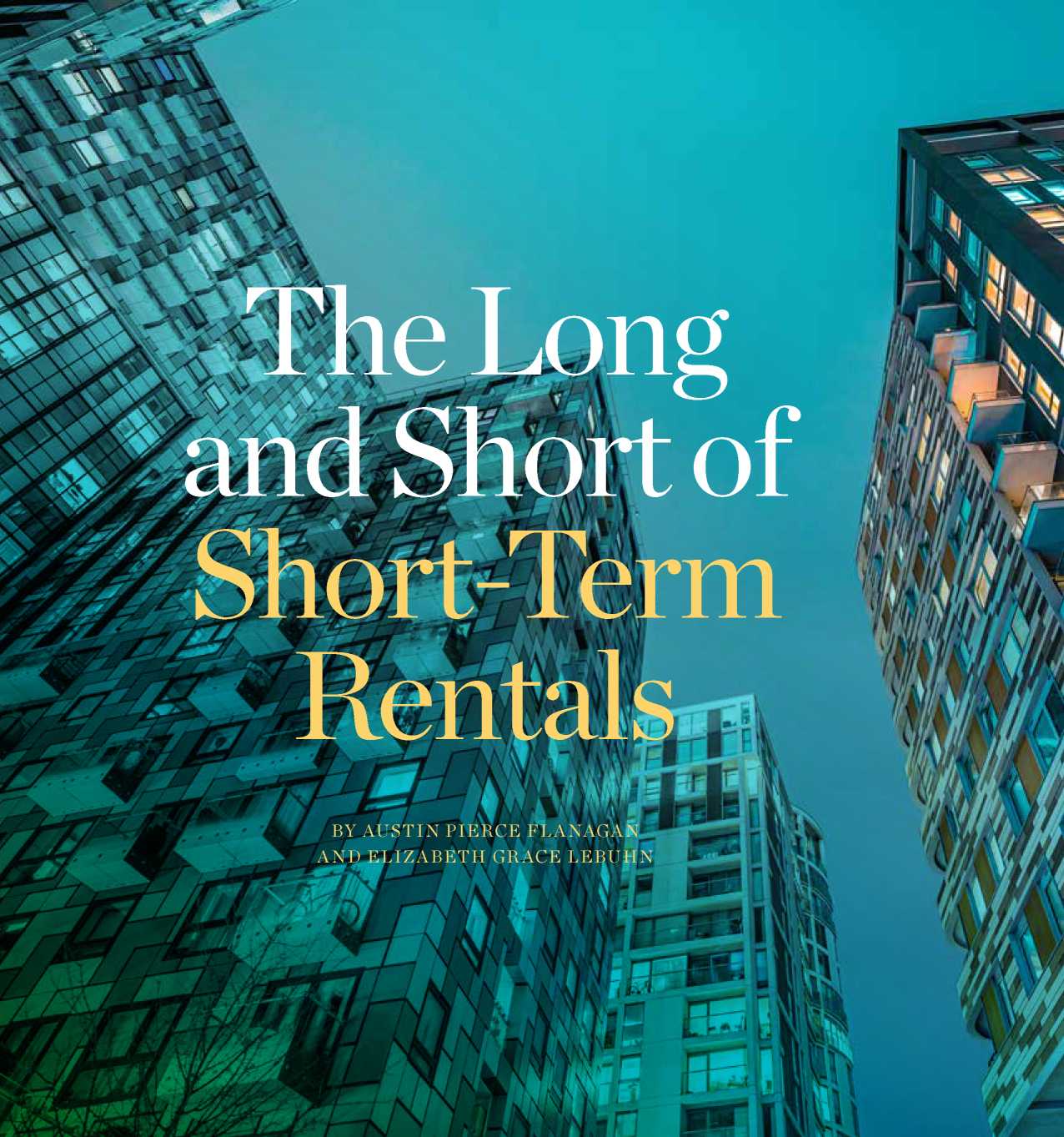The Long and Short of Short-term
| Publication year | 2023 |
| Pages | 28 |
FEATURE | REAL ESTATE


BY AUSTIN PIERCE FLANAGAN AND ELIZABETH GRACE LEBUHN
This article provides an overview of common legal challenges to short-term rental regulations across the country. With courts in other jurisdictions increasingly striking down restraints on short-term rentals, the risk associated with these regulations in Colorado is at a crossroads.
There are well over one million actively listed short-term rentals (STRs) in the United States, and that number is expected to grow.[1] The term STR generally refers to a residential property made available for occupancy for 30 days or less.[2] While online STR platforms have been around since the 1990s, the STR market exploded in 2008 with the emergence of home-sharing platforms like Airbnb. As property owners capitalized on the new economic opportunity, many communities and their local governments recoiled at an unwelcome change of character and scrambled to place parameters around STRs. Not long after these constraints emerged, challenges to invalidate them followed.
This article examines common legal challenges to STR regulations, providing the framework of potential legal ramifications these regulations create.[3] Because Colorado has seen relatively few published court decisions on STRs, this article analyzes caselaw nationally and contemplates how those holdings could apply in Colorado.[4]
Challenges to STR Regulations
Local governments have the authority to impose reasonable restrictions on land uses, including STRs, by regulating the location, type, and manner of permitted uses through their police power.[5] However, the police power is not without limitation, and regulated landowners may raise a variety of challenges to invalidate such regulations. The following addresses common challenges to STR regulations and is organized by the likelihood of each challenge being successful, starting with the least successful and specifying when a case arises in a Colorado court.[6]
Regulatory Takings
Overreaching zoning regulations could be considered one of two types of regulatory takings. The first results when a landowner has a compensable property interest and the regulation deprives the landowner of 100% of the property's use (often called a per se taking).[7]The second results when the landowner has a compensable property interest and less than 100% of the value is diminished.[8] In that case, the court will weigh three factors to determine if the regulation amounts to a regulatory taking, including "the regulation's economic effect on the landowner, the extent to which the regulation interferes with reasonable investment-backed expectations, and the character of the government action."[9] Often the determinative factor, the regulation's economic effect must result in a severe decline in the property's value for the court to consider the regulation a taking.[10]Precedent disfavors a regulatory taking finding unless the diminution in value is greater than 93%.[11]
It is unlikely that a court would find a restriction on STRs, including a scheme to phase out STR licenses or even a total ban on STRs, a regulatory taking. For instance, the court in Cope v. City of Cannon Beach did not find a regulatory taking even with a total STR ban and phase-out of current STRs because the city's scheme did not amount to a severe decline in property value.[12]
Exaction Takings
If a local government imposes conditions on a land use approval for STRs, those conditions may be challenged as an exaction. In Colorado, through the land use approval process, local governments can require developers to pay for the costs of public improvements and facilities needed for new developments.[13] When a local government requires, as a condition of approval, the dedication of private property for public use or a fee-in-lieu thereof (an "exaction"), there is a presumption that the condition effects a compensable taking.[14] This presumption can be overcome if the local government proves that (1) there is an "essential nexus" between the dedication or payment and a legitimate government interest, and (2) the dedication or payment is "roughly proportional" both in nature and extent of the impact to the proposed development or use of such property.[15]
In Krupp v. Breckenridge Sanitation District, one of the few Colorado cases involving STRs, the Breckenridge Sanitation District (the District) imposed a water plant investment fee on new developments as a condition of their land use approval. This was done so that the developers responsible for increased wastewater would pay for expanding the existing wastewater treatment facilities.[16] STRs were apportioned higher fees than long-term rentals because of their higher estimated wastewater usage.[17] STR developers challenged the higher fees as an impermissible exaction under the Takings Clause.[18]
The Colorado Supreme Court upheld the District's fee because it was legislatively established with evidence demonstrating higher wastewater impact from STRs than from long-term rentals.[19]Thus, the court found there was an essential nexus between the fees and the purpose of supplying wastewater facilities and that the higher fees for STRs were roughly proportional to the impact of STRs.[20]
Whether raised as an exaction or regulatory taking, challenges to invalidate STR regulations or conditions of approval are unlikely to be successful unless the local government imposes excessively burdensome and unsubstantiated requirements.
Equal Protection
The Equal Protection Clause of the Fourteenth Amendment ensures every person equal protection under the law, essentially requiring all similarly situated persons be treated similarly.[21]If a local law does not involve a suspect classification[22] or a fundamental right,[23] courts will apply the rational basis test to an equal protection challenge.[24] The rational basis test is deferential to local law, which is presumed valid and will be upheld if there is any "reasonably conceivable state of facts that could provide a rational basis for the classification."[25] The municipality need not articulate the reasoning behind the ordinance because "it is entirely irrelevant for constitutional purposes whether the conceived reason for the challenged distinction actually motivated the legislature."[26]
In Draper v. City of Arlington, homeowners alleged an equal protection violation after the city amended its STR ordinance to limit STR locations and require operational standards but did not apply such restrictions to long-term rentals.[27] The court found no equal protection violation because homeowners who leased their properties on a short-term basis were not similarly situated to those who leased their properties long-term, largely because STRs had different impacts on the neighborhood than did long-term rentals, including nuisance violations and over-parking.[28] Even if similarly situated, the court found that protecting the historical character of low-density residential neighborhoods was a legitimate purpose of the STR ordinance.[29]
Similarly, in Murphy v. Walworth County, the court found that STR homeowners were not similarly situated based on differing usage of electricity, water, and gas; the number of automobiles in the driveway; amounts of trash generated; and the short-term renters' lower interests in preserving the quality of life in a neighborhood (because they would soon leave).[30]
Calvey v. Town Board of North Elba presented a slightly different analysis. Calvey alleged that other rental homes in the town, zoned for the same purpose and taxed at the same rate, were substantially similar to properties that did not have the same restrictions on use as under the STR ordinance.[31] The court determined that such distinctions, if found arbitrary, were sufficient to sustain an equal protection claim.[32] Though the court denied an initial motion to dismiss the equal protection claim, the case was dismissed before reaching the merits.[33]
These cases suggest that an equal protection challenge to an STR ordinance is unlikely to succeed. At the outset, courts seem skeptical that short-term and long-term renters are similarly situated. Calvey describes similarities between short-term and long-term renters (e.g., the same zoning district, use, and tax rate), which may make this showing more likely, while Draper and Murphy give examples of how the two types of renters are dissimilar (focusing on neighborhood impacts like parking, traffic, and nuisances).
If a challenger demonstrates similarly situated short-term and long-term renters, they must then show no "reasonably conceivable state of facts that could provide a rational basis" for the distinction between the two renters.[34] There is no guidance in relevant caselaw indicating how a challenger could make such a showing.
Substantive Due Process
Substantive due process requires that a government not arbitrarily or capriciously deprive a person of the legitimate use of their property.[35]In Ewing v. City of Carmel-by-the-Sea, decided over 30 years ago, homeowners alleged that a zoning ordinance prohibiting rentals for fewer than 30 days was an unconstitutional substantive due process violation.[36]
The homeowners argued that the city's prohibition of STRs arbitrarily restricted STRs while allowing other types of longer-term rentals and transient commercial uses in the same zoning district.[37] The homeowners also complained that the city drew an arbitrary line by permitting rentals of 30 consecutive days, but not 29 or less.[38]
The court found that prohibiting STRs in part of a low-density residential district was reasonable because it furthered the city's purpose of preserving the area's residential character.[39]In upholding the ban, the court emphasized the threats STRs pose:
...
To continue reading
Request your trial
